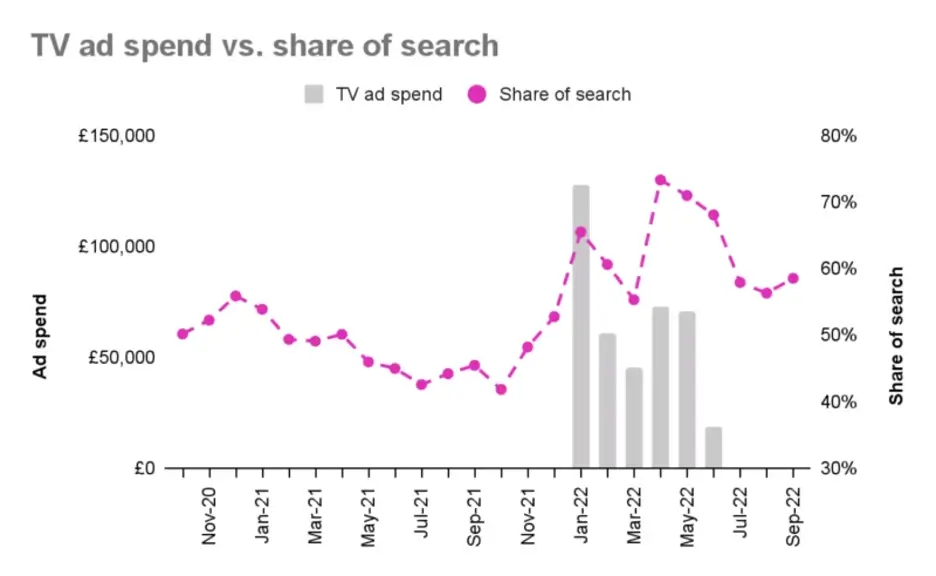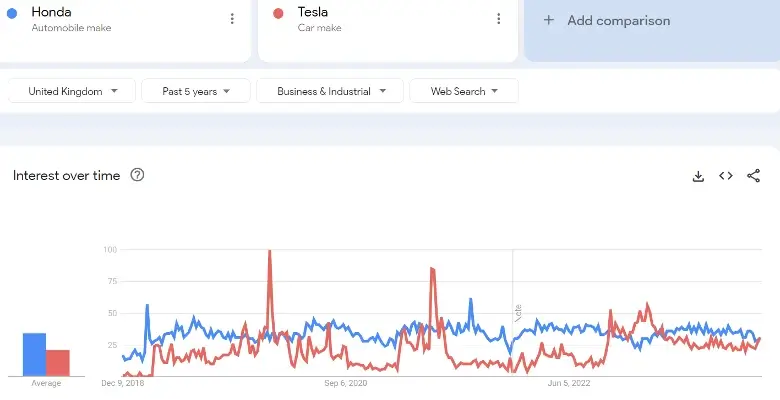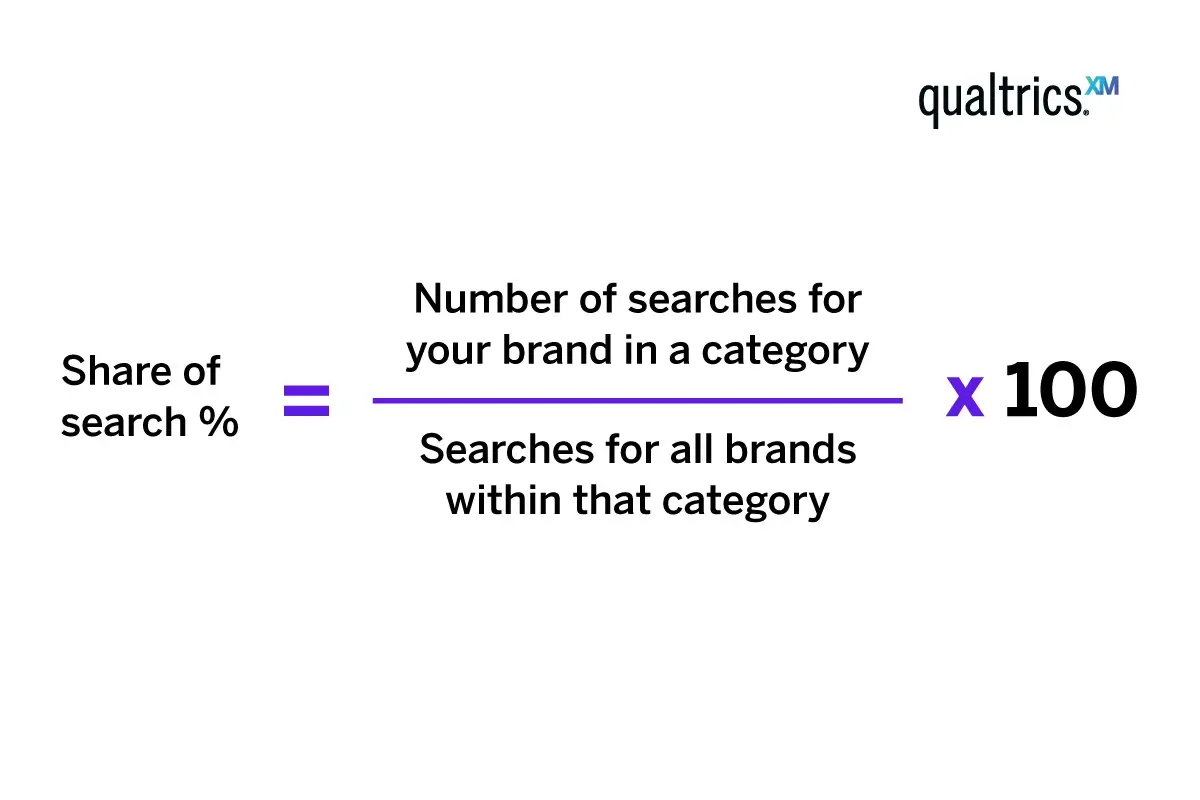Brand Experience
Understanding share of search and what it means for your business
Share of search might be a newer term being used in market research, but it’s a powerful tool for understanding your business’ position in comparison to your competitors. Learn how to measure and leverage share of search with our guide.
What is “share of search”?
Share of search is the number of organic search queries made for your brand, considered in proportion to all searches made for similar brands.
It’s a search engine-focused approach to understanding how your brand stacks up against the competition, using the volume of search terms as a metric for comparison.
Though it might seem as though share of search is only important for your marketing teams, it’s actually a useful metric for many of your other business departments.
Free eBook: How to build a world-class brand tracker
How is it different from a brand’s market share?
Calculating a brand’s share of search can seem somewhat similar to finding out a brand’s market share. However, instead of examining proportion of sales or revenue as a metric for comparison, the focus is on search volume specifically.
It’s much easier to find data on search volume than it is to find information on private business sale numbers. There are plenty of tools that can help you compare the results for your business’ key terms with those of your competitors. Market share is often an estimate - with search volumes and the right analytics tools, you can see the direct relationship between search and sales.
How is it different to share of voice?
Share of voice measures proportion of a business’ media spend, rather than revenue generated or search volumes achieved. Once again, share of voice can be difficult to pinpoint with accurate data on advertising spend often kept under wraps.
Why share of search is important
There are a number of reasons why tracking share of search can help you improve your business. Here are the main ones to be aware of:
It can help with sales predictions
There’s a good correlation between share of search, share of market and sales, giving you a useful tool for predicting potential business outcomes. MyTelescope’s study found that across countries, categories and languages, the average correlation between share of search and share of market was 83%. This high correlation was also seen between share of search and sales.
It can indicate the success of your overall marketing and PR efforts
The share of search metric can help you when evaluating your overall marketing and PR efforts, such as TV adverts, billboards and more. For example, agency AIP found that brand awareness increased significantly along with share of search (relative to their client’s closest competitors) when running TV advertisements, as seen in the graph below.

Image from: aip.media
Share of search remained 15% to 20% higher year on year after running the adverts, illustrating how even when marketing campaigns have ended, share of search can indicate increased brand salience over time.
It can give you a good understanding of your SEO success
Share of search can also help to indicate the efficacy of your search engine optimization (SEO) efforts. Increasing brand recognition and improving brand reputation are often key goals for SEO campaigns, so keeping track of your share of search is a good way to monitor this progress. The easier it is for a potential buyer or customer to find you online, the better the chances of improving your revenue.
It can lead to improvements in your conversion rate
Branded search traffic usually has a much better conversion rate than non-branded. Despite this it is sometimes taken for granted or ignored by SEO teams under the premise that they can’t do anything to improve it (most brands will rank in 1st position for a branded search).
However, by focusing on SoS as a metric and using it to measure other marketing and outreach efforts as described above, it’s possible to improve brand recall and recognition and with this, organic search traffic and conversion rates.
Using Google Trends to calculate share of search
Google Trends is a free tool provided by Google to help you to see your keyword search volume trends. It can give you a general overview of your brand’s presence within your market, as well as the same information for your competitors. Once you’ve collated your brand’s Google Trends data and that of your competition, you’re able to see an overview of your share of search.
You can search by location and search for specific terms, or just a topic (collection of related terms). You can see real-time search trends, daily search trends and trends over specific periods of time. Sorting by category means you can narrow down the results enough to see how you compare to others in your market.

How to calculate share of search
Gather your search data and analyze it
Using Google Trends, gather share of search data for your brand and for your nearest 5 competitors. It’s important to look at the search topics as well as search terms. Search terms give you the volumes for those specific queries, but search topics include all terms that have the same concept. An example would be searching for the search term “Honda Civic”, versus searching for the more general “Autos & Vehicles”.
You’ll get a dashboard of results that indicate where you stand when compared to others in your market.

Calculate your share of search
Now you’ve got your data on you and your competitors’ search volumes, you can calculate your share of search. You can use this formula to do so:

Compare your results over time
Your brand’s share of search over time will change as your brand reputation grows and as campaigns are released. Make sure to keep track of your brand’s share of search over time to understand when is best to launch new outreach and what new terms your customers are looking for when they search for your brand.
Track the impact of your campaigns
Make sure you particularly pay attention to the influence of your marketing and PR efforts on your share of search, not just immediately, but in the months and years afterwards. Brand visibility can take time to take off, but once it does, search volumes can increase dramatically. Include results from your paid advertising and your regular output for online visibility.
Caveats to using share of search
However, there are caveats to using share of search as a metric for brand health. These are:
Not all searches will yield the same precise results
If your brand name is a common word or name - such as mattress company “Emma” - search volumes will become muddied with irrelevant search results. There can also be problems if your product is typically a catch-all term for a category, such as Kleenex for tissues. This can make getting firm results quite tricky. Some share of search tools - such as Google Trends - do distinguish between company and brand names and generic search terms, so this may not always be an issue.
There’s also the fact that some brands won’t be searched for as widely, even if they are big players in their market. For example, if you’re an Apple user, you might go to Apple’s site directly and search for what you need, rather than using a search engine to do the same. This can throw off your share of search results as well.
You need to understand the relationship between search data and intent
Survey-based measurements of attitudes toward brands have already been found to be a good predictor of sales, but what’s the relationship between search volume and intent to engage?
Studies have found that brand search volume can be a strong indicator of brand health, but past history might also influence search volumes in a way that can blur results. For example, search users who own a specific branded item may search for that brand even though they do not intend to make a purchase. This might influence the clarity of the results, as not everyone searching will be in the right sales stage to make a purchase.
Using Google Trends alone won’t give accurate insights
There are limitations to using free tools such as Google Trends. Not only does it limit the results of organic searches to one search engine, but search topics can miss the key search terms that you might appear for. The category you’re looking into can also affect the type of results you find. For example, larger purchases such as for an automobile will probably generate searches - but choosing which chocolate to buy likely won’t create search volumes.
Google trends data is also relative when looking at the graph results, rather than being fully accurate. For example, when it lists 100 searches taking place in a particular month, it indicates that this was the peak time for that search term, not that 100 individual searches took place.
The Google Trends graph can give you an overview, but not a fully accurate view of your results. Your share of search can still be calculated, but it’s always going to be an estimate unless you download a .CSV file and look at the specific numbers.
How to leverage share of search trends data
Once you have your share of search data, there’s plenty you can do to leverage this information to your advantage. Rather than finding this information and seeing it as a static insight, you can use the information you find to elevate business outcomes and outdo your competition.
You can:
- Increase share of search by replicating outreach campaigns that worked well for raising search volumes
- Add your search volume data to the knowledge you’ve already collected on market share to bolster your predictions about future business returns
- Examine search results for topics your brand is relevant for and expand product lines and service offerings to fit new expectations from your audience - for example, adding a new colorway that’s being searched for
- Understand more about your customers’ queries and make sure you’re providing answers - for example, are your audience trying to compare your products to others, or are they unsure how to use the products you offer?
Free eBook: How to build a world-class brand tracker
